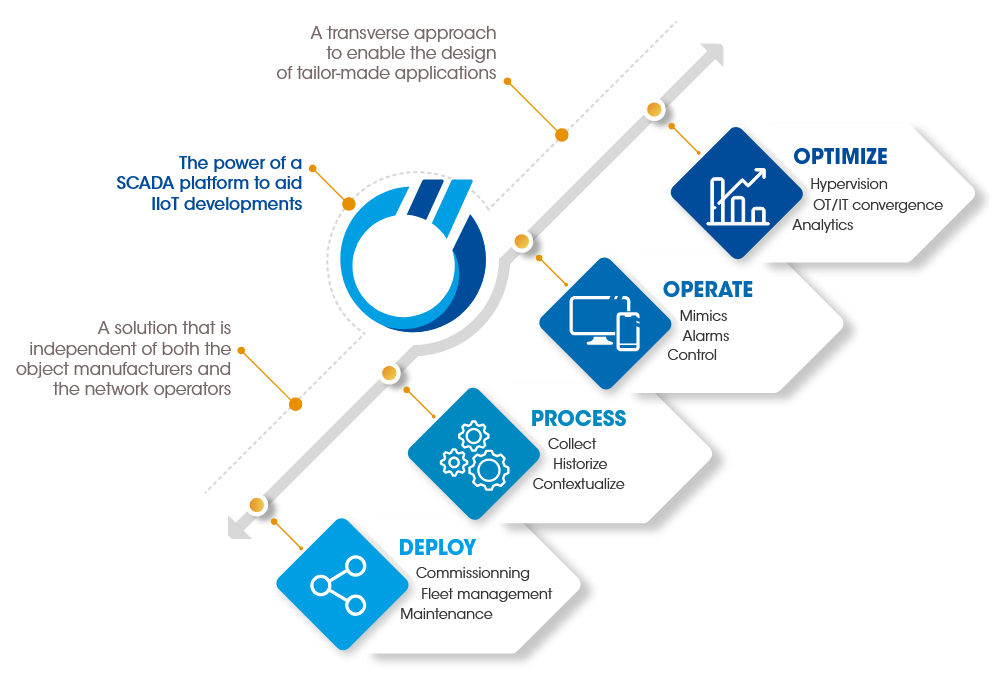Connected Objects & Industrial IoT
Embrace the IoT and rise to the challenge of the smart city and Industry 4.0!
IoT and Industrial IoT solutions are disrupting traditional architectures and providing innovative new ways of collecting and processing data. With benefits including ease of deployment, low cost, and long range communication capability, the development of IoT will transform your capacity to collect critical data. By leveraging the increased amounts of data delivered from the field, new uses and services can be invented according to your field of activity, whether it be car manufacturing, computer hardware, health, etc. Panorama natively assimilates this IoT trend, turning the SCADA platform into a solid foundation for building OT/IT convergence for Smart City and Industry 4.0 players alike.
Internet of Things – 3 main components
The Internet of Things consists of three main components: objects, physical networks and platforms. Objects including sensors collect data directly in the field. In an urban setting, this could be from an individual building, a group of buildings, or an entire smart city. Networks, which use proprietary technology infrastructures, manage these objects from a connectivity point of view. They transport data detected by sensors over long distances (range of the order of several kilometers) and make it accessible to operating platforms. Whether they be cloud-based or local (“on premise”), these platforms are used to centralize the data for subsequent processing via remote applications or apps. The Panorama platform goes much further. It natively ensures:
- local decoding of messages,
- management of fleets of heterogeneous objects throughout their life cycle,
- provisioning of your IoT tech project with all the critical functional resources of a SCADA platform: Alerts & Alarms, Business Ergonomics & Mimics, Mobile Interfaces, Advanced Data Processing etc.
From a fleet of IoT devices to an IoT platform focused on analytics and operations
IoT devices are pieces of hardware that usually have their own power source and are capable of transmitting the data which they capture locally. This could be a temperature, a discrete input or a metering index, etc. When implemented in a SCADA application, the devices are digitized. Their physical reality is duplicated in a virtual digital model. This principle can be massively extended using the IoT and the SCADA mechanisms as a means of digitizing complete physical environments and processes, up to the scale of an entire smart city, industrial complex or infrastructure network. Of course, SCADA tools such as Panorama Suite can already monitor and control all types of processes. By adding IoT functions, it is possible to go even further in optimizing the life cycle of installations.
Big data, BIM, deep learning algorithms and artificial intelligence (AI) are the next phases of the digital transformation already underway. SCADA platforms such as Panorama actively contribute to building the solutions for this global revolution. Our sole ambition is to support the innovation of our customers in a very concrete way and ultimately serve the interests of users and consumers.

“The challenge ahead is no longer to capture and store data, but to use it intelligently“
At the heart of the OT/IT convergence with Panorama
SCADA solutions devoted to automation (this is OT: Operational Technology) are nowadays proven and often of high quality. In parallel, there are many vertical platforms originating from the world of IT (Information Technology) reserved for hyper-specialized IoT uses (parking, leakage, meters, health, etc.). Few of them, however, natively support the convergence of both worlds. Codra has been a forerunner in this area, offering OT/IT convergence at the heart of its Panorama SCADA application. Critically designed as a secure environment, interoperable with third party applications and offering comprehensive functional coverage, the Panorama platform is the ideal backbone for your technical information system.
Where connectivity is key to the success of your IoT projects
IoT features have been built into our SCADA system at different levels. Firstly, through integration of the client & server MQTT protocol (MQTT broker), and then with the integration of connectors to the cloud or private back offices of operators (SIGFOX and LoRaWAN). We are also researching the integration over the longer term of other technologies based on the same ideas, such as 5G.
At the device level, the Panorama platform supports intelligent device management (commisioning / decommisioning) as well as the processing and fine analysis of stored data. In this way, the data can be connected, correlated and cross-referenced with real-time data from PLCs. This makes it possible, for instance, to generate control loops in a highly cost-efffective way.
From Internet of Things to “servicialization” of assets
OT/IT convergence, achieved through the interoperability of platforms and connected devices, is allowing companies to develop new services as of today. These innovations pave the way for increased competitiveness and why not new market insights and opportunities. In manufacturing, it is becoming more and more common to rent the use of machines or assets instead of buying them. The hyper connectivity of the hardware assets allows their manufacturers and suppliers to ensure availability rates (and therefore monthly invoicing levels). The benefits of predictive maintenance are there to be leveraged too! This economic paradigm shift is already standard practice in the aero engines sector of the global aerospace industry. Eventually, this IT “servicialization” is likely to be extended to many sectors of the economy, from cars and airplanes to medical equipment and healthcare.
